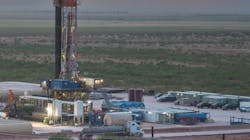SM Energy hikes 2023 production guidance on South Texas gains
Thanks to higher production in South Texas, two acquisitions and an easing in cost pressures, the leaders of SM Energy Co. have raised their output forecast for 2023 by 1 MMboe and lowered their capital spending guidance by $50 million.
The team led by president and chief executive officer Herb Vogel also has finalized a deal to pay $93.5 million for 20,000 net acres in Dawson and Martin counties in the Permian basin and bought 2,800 acres in the Midland basin adjacent to the roughly 6,300 it acquired earlier this year.
The lift in SM Energy’s production forecast from South Texas—which has the company on track to come in 4% higher than its initial second-quarter expectations—is being driven by both well performance and the faster-than-expected completion of additional oil handling capacity. Speaking to the JPMorgan Energy, Power & Renewables Conference June 21, Vogel said SM’s Austin Chalk oil-heavy production is now flowing through larger pipes and able to handle the better-than-expected performance from both older wells and those put into service more recently.
SM Energy's leaders now expect second-quarter total production to be about 13.9 MMboe versus their previous midpoint guidance of 13.4 MMboe and full-year output to be 53.5-55.5 MMboe (OGJ Online, Apr. 28, 2023).
The 20,000-acre Midland acquisition, which today has net production of 1,250 boe/d (90% oil), will account for about 20% of the full-year production increase. SM Energy executives expect to focus on developing the Dean and Middle Spraberry sand intervals of their new holdings and are looking to break even below $50/bbl oil prices.
“It doesn’t mean anything if you just add acres just for the sake of acres,” Vogel told his audience at the conference. “We’re really adding on break-even-below-$50-a-barrel type of inventory.”
The big-picture goal, Vogel added, is to sustainably add inventory—today, that’s between 10 and 13 years in both the Midland basin and South Texas—to SM Energy’s operations and lift the company’s annual growth rate to the mid-single digits. In the Austin Chalk, he said, plans call for the development of 400 wells, up from about 75 today.
Another tailwind for the SM Energy team is an improving capital expenditures picture, particularly when it comes to diesel and steel prices—Vogel said $80 million of the company’s roughly $900 million capital budget in 2022 went to diesel. Also contributing is the fact that rig services spending has been “pretty flat” this year whereas SM Energy's leaders had budgeted an increase from 2022 levels.
Some of the capex savings will go toward the addition of a rig in the Midland basin starting in October 2023, which is expected to support stronger oil production volumes in 2024. That addition will grow SM Energy's rig network to four in West Texas and six overall.
Adding to comments about falling input prices, Vogel suggested more could be on the way as the effect of falling rig counts work their way through the industry. That echoes some of the findings from the Federal Reserve Bank of Dallas’ latest quarterly survey of industry executives (OGJ Online, June 22, 2023). The bank’s report showed that a greater number of operators are beginning to see development, labor and operating lease costs drop.
Shares of SM (Ticker: SM) were up more than 2% to $29.30 in afternoon trading June 23. Year to date, they have given up about 8%, trimming the company’s market capitalization to about $3.5 billion.
About the Author
Geert De Lombaerde
Senior Editor
A native of Belgium, Geert De Lombaerde has more than two decades of business journalism experience and writes about markets and economic trends for Endeavor Business Media publications Healthcare Innovation, IndustryWeek, FleetOwner, Oil & Gas Journal and T&D World. With a degree in journalism from the University of Missouri, he began his reporting career at the Business Courier in Cincinnati and later was managing editor and editor of the Nashville Business Journal. Most recently, he oversaw the online and print products of the Nashville Post and reported primarily on Middle Tennessee’s finance sector as well as many of its publicly traded companies.

